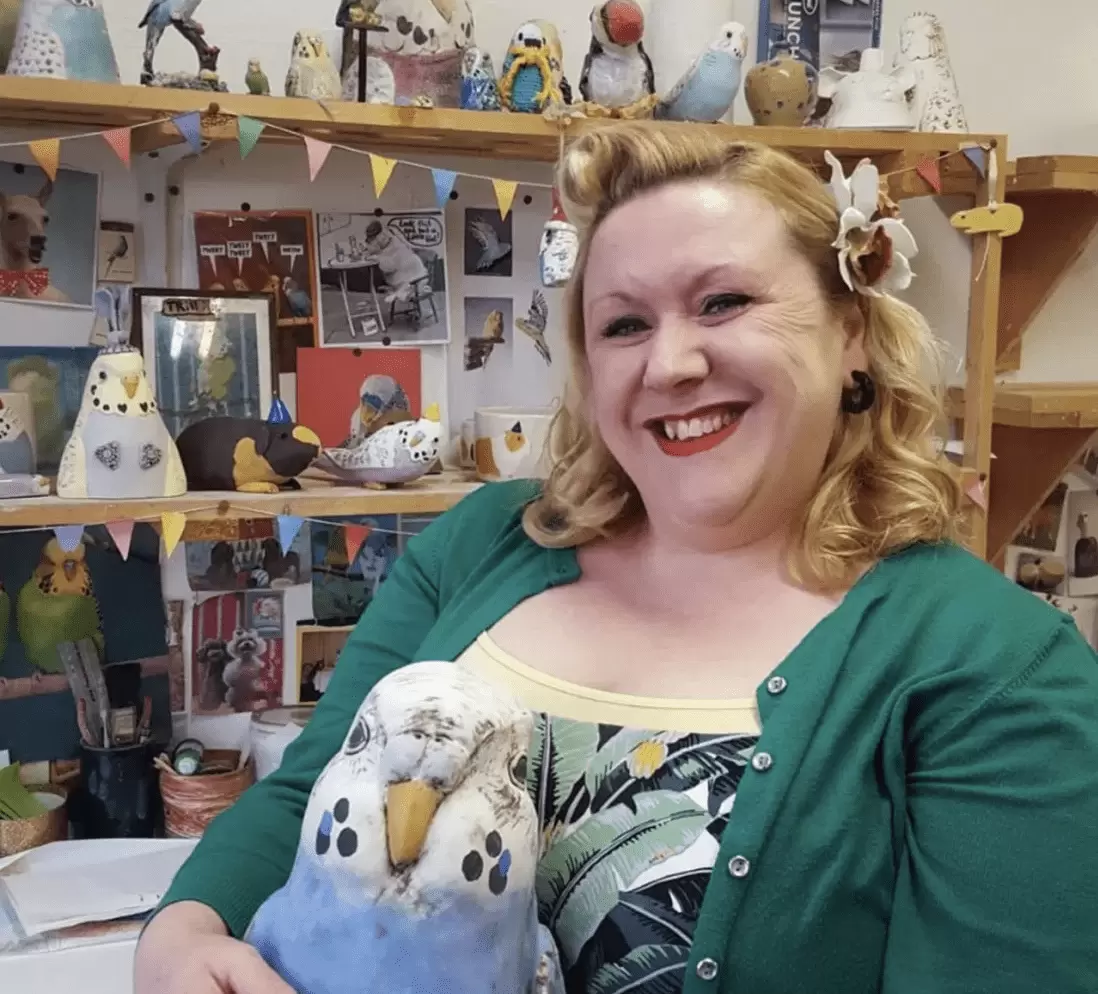Want 10% off your order? Join Club Holly & Co

How to price your product
Product & Inspiration
With Charlotte Miller, founder of Charlotte Miller CeramicS
UPDATED 12TH SEPTEMBER 2023
Setting the right price for your products will help determine how well they sell. How do you calculate the price correctly? Charlotte Miller from Charlotte Miller Ceramics shares the expert pricing tips and pricing strategy she’s learnt over the years…

How to determine the price of a product
When pricing your products, first consider this: Would you sit at a desk for eight hours or more every single day without a salary? Do you sometimes think that anyone can do what you do? If your skills come naturally to you, do you think that they’re not worth much? These are big, important questions because the future of your business hinges upon knowing your worth and pricing your efforts inline with this.
How do you price your products currently?
- Do you charge for your time (all of it, not just an estimate)?
- Do your charge properly for your expertise?
- Or do you decide a price that you yourself would be willing to pay (which is what a lot of small businesses do)?
It can be scary to get down to the nuts and bolts of what it costs you to produce your product, from the materials you use, to the electricity, but that’s how granular we need to get to price a product correctly.
Meet Charlotte Miller from Charlotte Miller Ceramics
Charlotte Miller is a Bournemouth-based ceramicist who is primarily known for her ‘showgirl’ budgie pieces (but also has a penchant for guinea pigs and hamsters). Her colourful, kitsch designs have a cult following (remember, the riches are in the niches when it comes to products), but setting up her business was a result of being made redundant from her teaching job rather than a grand plan, so pricing was somewhat of a mystery.
It can be scary to get down to the nuts and bolts of what it costs you to produce your product, from the materials you use, to the electricity, but that’s how granular we need to get to price a product correctly.
Charlotte Miller’s experience of pricing products
For Charlotte, things came together very quickly from the moment she set up a Facebook page to share her creations and got lots of interest. Knowing the value of her products though — and charging accordingly — has been part of a slower learning curve.
She said, “I hadn’t actually considered price, which is absolutely ridiculous. So at the very beginning, I very much guessed what it should be — so wrong, don’t do that people! I was just like, ‘Yeah, that sounds good, that sounds right,’ and the basis of that was, what I would pay or what I would buy. And I’m not my customer, so that is where I went wrong.”
When you add up the numbers to work out your cost price, and then mark it up so that you can actually pay yourself a salary, you might think, “Ooh, that sounds too much.” But the fact remains that you’ve done the sums and that is the real price.
The ultimate guide to pricing strategies
- Don’t just think what you would pay for products: As Charlotte says, you’re not your customer — don’t try to imagine what they might think when they see the price tag. The right customer will recognise the value of your work and be willing to pay it.
- Remind yourself that you wouldn’t take on a normal job and work for next to nothing: When you first start a business, working for yourself may be a bit of a hobby, but it’s not a hobby anymore. It’s the route to living the life you want to live, and you can’t do that if you’re paying yourself less than minimum wage.
- Work out what you would need to survive and set prices accordingly: Use that as your benchmark for your first year in business, and go from there.
- Also consider what you might need to grow your business without making sacrifices (and read our article to see how to scale a business without losing the magic for tips).
- Take into account the cost of your monthly spend on raw materials and other bills: From energy costs (for Charlotte this includes firing the kiln, for example), rent if you have studio or shop space, postage and packaging, and of course, your salary. As an example, if you pay yourself £15,000 per year, your time is worth £6 an hour — less than minimum wage.
- Ask yourself how much you would like as an annual salary: Then divide that by earning hours per year (roughly 2,500 by our estimate) to get your hourly rate.

"I evaluated all the products that I make and asked, ‘Are they still valid? Are they still worthwhile? Does this thing take me too long to make? Is it selling for the price that it’s at? If I need to charge double that, will it sell?’ And then I thought, ‘Well perhaps I won’t make that…’"

Why is it important to review prices regularly?
It’s important to review your prices every year — and to increase your salary every year to reflect the cost of living (a salaried job offers a raise of 3-5% in a good year). In fact, a review is a great way to look at your stock and understand what people are buying and what they aren’t. Be honest with yourself and if something is too time-consuming or not bringing in a reasonable return on investment, it may be time to let it go with love as Charlotte did.
She said, “What I did in lockdown is, I evaluated all the products that I make and asked, ‘Are they still valid? Are they still worthwhile? Does this thing take me too long to make? Is it selling for the price that it’s at? If I need to charge double that, will it sell?’ And then I thought, ‘Well perhaps I won’t make that…’ So that’s what I’ve done with some little ceramic brooches, which I really loved, but they just weren’t selling at the higher price point. And they were so bleeding fiddly, quite frankly, it wasn’t worth it!”
Create product ranges with different price ranges
Another way of thinking about your stock is to…
- Create ranges which have different price tiering — good, better, and best.
- Think about how you can make some processes and pieces less labour intensive to create these tiers. The busts Charlotte uses for her budgies are partially mould-made to help with production time, for example.
- Think how you can then use this time more effectively instead. By using moulds, Charlotte has more time to spend hand-decorating her unique and whimsical sculptures, which she enjoys.
- Consider the benefits. Using moulds makes Charlotte’s sculptures more affordable than if she hand-moulded each individual bust, allowing her to offer ‘budgies for all’.
How to strategically lower prices on some of your products
When it comes to mugs though, Charlotte found it difficult to justify her pricing to herself, and said, “Because I do sculpture, I think for me sculpture has that status of, ‘Ooh I’ve bought a fabulous sculpture,’ so you feel like you can charge more. I’ve always struggled with the pricing [of mugs] because I was like, ‘Are people gonna pay thirty quid for a mug?’ I dunno, it’s a mug innit?!”
So Charlotte bought blank mugs, put her illustrations on them using transfers, and then fired them. Doing this meant she could charge less because they weren’t made from scratch. Now Charlotte’s developed a home range with mugs that are hand-thrown and hand painted for the price of £28 which she feels comfortable with.
"Because I do sculpture, I think for me sculpture has that status of, ‘Ooh I’ve bought a fabulous sculpture,’ so you feel like you can charge more. I’ve always struggled with the pricing [of mugs] because I was like, ‘Are people gonna pay thirty quid for a mug?’ I dunno, it’s a mug innit?!”
How to value yourself and your work — and why it’s important to do so
It’s taken Charlotte time to get to this point though, and she’s keen to encourage others not to make the same mistakes that she did. She said, “For me it was about having a status in the craft world, that I felt that I was valued, and could charge those prices.”
As we all know, it’s as much about self-worth as it is about valuing your work, so start as you mean to go on. If it feels tough working through these, take comfort in the fact that we’ve all been there and many small businesses are going through the same thing right this very moment. Your work is good and you have every right to charge for it.
Remember, if you devalue your work, you are also devaluing the work of your fellow craftspeople. So create a pricing strategy, check it’s right, then stick to it. And do review it regularly. If you need to amend your prices, customers will likely understand as long as you explain to them why you are doing it and bring them on the journey.
How to price your product: key takeaways…
Remember the following four points.
1. When pricing your product, don’t underestimate how unique you are:
What’s your USP? Are you the only person who does what you do? Do people say to you, “I could never do that”? Own that uniqueness. Tell the story. There is only one you.
2. Factor the time it takes into the cost of a product. Don’t devalue your time:
Just because it feels like you’re being paid to have fun, your creativity is your work so make sure you are getting paid for it.
3. Don’t keep telling yourself, “I wouldn’t pay that for the product”:
Your perception of what’s expensive has nothing to do with the value of your work in the eyes of the right customer.
4. Don’t be afraid to explain your prices to customers:
Share exactly what goes into your product or why prices may have gone up. Your customers will most likely understand this if they know what’s behind it.

Related products
Related content
MORE ARTICLES ON PRODUCT & INNOVATION

Why niche products sell: the riches are in the niches
Product & Innovation

Why innovation is important in business and the best way to innovate
Product & Innovation

Why my word of the year was creativity
Product & Innovation

Discover what makes an amazing product
Product & Innovation

Where and how to sell your products and services
Product & Innovation

How to know when a business idea isn’t working
Product & Innovation

Giving your products soul through emotional connection
Product & Innovation
Be the first to know
Sign up to our emails for brand new small business magic and inspiration. And if you create an account, you’ll also get exclusive product drops, discounts and more from Club Holly & Co, too.

